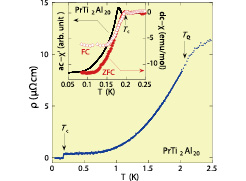Heavy Fermion Superconductivity in the Ferroquadrupolar State in the Quadrupolar Kondo Lattice PrTi2Al20
Nakatsuji Group
Orbital degree of freedom provides a various interesting phenomena such as colossal magnetoresistance, orbital ordering, and quantum spin-orbital liquid states. Although orbital degree of freedom strongly couples to spin and charge degrees of freedom in d-electron systems, f-electron systems with 4f2 configuration, such as cubic Pr and U based compounds, sometimes exhibit nonmagnetic ground state with a pure orbital degree of freedom known as quadrupole moments. In analogy with magnetic Kondo lattice systems, two competing interactions, RKKY type intersite coupling and quadrupolar Kondo effect, can be induced in quadrupolar Kondo lattice systems due to hybridization between 4f quadrupole and conduction(c-) electrons, which may lead to novel quantum criticality of quadrupole order.

Fig. 1. Temperature dependence of the resistivity below 2.5 K in PrTi2Al20 (solid circle). Arrows indicate the ferro-quadrupole transition temperature TQ = 2.0 K and superconducting transition temperature Tc = 0.2 K. Inset: T dependence of the real part of the ac-susceptibility (solid line) and dc-susceptibility for zero field cooled (ZFC, solid circle) and field cooled (FC, open circle).
Recently, we revealed that PrTr2Al20 (Tr = transition metal) is the first ideal quadrupolar Kondo lattice system that allows us to tune the hybridization strength and the quadrupolar ordering temperature [1]. Among them, PrTi2Al20 is the best studied and established to have nonmagnetic Γ3 crystal electric field ground doublet with ferroquadrupolar ordering at TQ = 2.0 K [1-4] as well as strong c-f hybridization [1, 5].
Here, we report the heavy fermion superconductivity at Tc = 0.2 K in the ferroquadrupolar ordered state of PrTi2Al20. The temperature dependence of critical field Bc2 and weak differential paramagnetic effect indicate type-II superconductivity. Estimated effective mass m* from Bc2 and Sommerfeld coefficient γ is ~16 m0, indicating moderately enhanced m* by hybridization. The positive ∂2Bc2/∂T2 at ~Tc and sensitivity of Tc to sample quality suggest the multi-gap nature of the superconductivity. These features provide an interesting counterpart to the superconductivity at Tc = 50 mK in the antiferro-quadrupole ordered state of PrIr2Zn20 [7, 8], where in contrast 4f electrons are well localized. More enhanced Tc and Bc2 in PrTi2Al20 should come from the mass enhancement due to the strong hybridization between 4f and c-electrons.
References
- [1] A. Sakai and S. Nakatsuji, J. Phys. Soc. Jpn. 80, 063701 (2011).
- [2] T. J. Sato, S. Ibuka, Y. Nambu, T. Yamazaki, A. Sakai, and S. Nakatsuji, arXiv0301828.
- [3] T U. Ito, W. Higemoto, K. Ninomiya, H. Luetkens, C. Baines, A. Sakai, and S. Nakatsuji, J. Phys. Soc Jpn. 80, 113703 (2011).
- [4] M. Koseki, Y. Nakanishi, K. Deto, G. Koseki, R. Kashiwazaki, F. Shichinomiya, M. Nakamura, M. Yoshizawa, A. Sakai, and S. Nakatsuji, J. Phys. Soc. Jpn. 80, SA049 (2011).
- [5] M. Matsunami, M. Taguchi, A. Chainani, R. Eguchi, M. Oura, A. Sakai, S. Nakatsuji, and S. Shin, Phys. Rev. B 84, 193101 (2011).
- [6] A. Sakai, K. Kuga, and S. Nakatsuji, J. Phys. Soc. Jpn. 81, 083702 (2012).
- [7] T. Onimaru, K. T. Matsumoto, Y. F. Inoue, K. Umeo, Y. Saiga, Y. Matsushita, R. Tamura, K. Nishimoto, I. Ishii, T. Suzuki, and T. Takabatake, J. Phys. Soc. Jpn. 79, 033704 (2010).
- [8] T. Onimaru, K. T. Matsumoto, Y. F. Inoue, K. Umeo, T. Sakakibara, Y. Karaki, M. Kubota, and T. Takabatake: Phys. Rev. Lett. 106, 197201 (2011).
